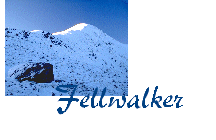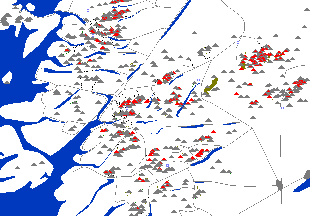


Munros, Corbetts, Nuttalls, Hewitts, Wainwrights, Murdos, Matts......
The hills can be classified in at least three ways :-Historical / Traditional
If a hill has always been regarded as a summit by locals and mountaineers.
Mathematical
The rule of "above 2000
ft" at first seems obvious, simple and ideal. That is until the matter
is investigated in more detail.
Consider the question
of two adjacent hills separated by a col. We may set a minimum re-ascent
between the two hills for them to "count". We may also wish to reduce this
value if the two summits are far apart.
So far so good.
These
rules cover most eventualities. Some systems also allow "peculiarity of
formation" or similar to allow for the problematical cases.
Where it becomes
difficult
Spot heights are not
generally available for cols between hills. In critical cases on site surveys
will be needed as carried out by the Nuttalls.
If a separating col
is submerged under a loch/lake. Do we use the surface of the water or the
submerged col?
Do we allow man made
structures to influence the calculation? A quarry perhaps. If we decide
no, and we have decided that water level "counts", do we disallow a loch/lake
if it subsequently dammed by man?
If two hills are of
identical height separated by a col of less than the required drop. Which
one (or both) is/are the qualifying summit !
The complexities are
arcane and endless but in practice apply to only a few hills.
What does cause problems here is the fairly regular revisions to mapping by the OS, the Munro tables having to be revised again and again as small discrepancies come to light.
Aesthetic
What "looks" like a mountain. Blencathra and Skiddaw in the northern Lakes clearly are two mountains and all lower ground around them can be regarded as subsidiary tops of the two hills. This approach becomes much more problematical if the Helvellyn range is considered. It will also be noted that as hills become more extensive the number of summits decreases. Compare the density of what are considered separate hills in the Highlands with the Lakes or Snowdonia.
A list of lists
Munro
Historical list of Scottish mountains of 3000ft. originally published in 1891. Revised by SMC at various intervals to reflect improved mapping etc. Currently 284 or 511 with subsidiary tops.
Elmslie
Rev. Elmslie's list of 2000ft. hills in England. Published 1933.
Simpson
F.H.F. Simpson, English and Welsh hills 1940.
Corbett
Scottish 2500-3000ft summits with a drop of 500ft between summits. Currently 221.
Old Donald
Scottish lowland hills of 2000ft or more with complex rule for separation. Currently 140
Donald
Scottish lowland hills of 2000ft or more with 30m. drop all round. 118
Graham
Scottish hills between 2000 (610m) and 2499ft. (761m) with a drop of 150m. all round. Currently 224
Murdo
Scottish hills of 3000ft with 30m. drop all round. 444.
Hewitt
Hill of 2000ft with drop of 30m all round.Wales 137, England 178. Scafell qualifies.
Nuttall
English and Welsh hills of 2000ft with a drop of 50ft between them. 432. This system gives the Scafell range nine summits (Scafell's north top Symonds Knott qualifies along with Middleboot Knotts near Piers Gill and Round How, the south top of Great End)
Wainwright
The phrase doing the
"Wainwrights" is now often heard in the Lakes. The inclusion of Mungrisdale
Common (a shoulder of Blencathra to its north with no reascent)
would indicate his books were based on completeness rather than any mathematical
rule, and were none the worse for it. 214.
The total rises to
316 if including "The Outlying Fells". These smaller hills range in height
from Walna Scar at 2035' to Humphrey Head at 172'.(Humphrey
Head has the further distinction of not even being in the Lake district
proper).
Marilyn
The relative hills of Britain. Any summit with a drop of 150m. all round. England 178, Wales 156. (Scafell does not qualify here).
Kirk
4533 British hills of 500m with a 20m drop. Unpublished
Synge T.
646 Lakeland summits
of 300 metres in height1. To qualify as a separate fell a reascent
of 30 metres is required. Other hills are treated as subsidiary tops.
The book uses a symbol system to identify the following criteria - 1.Over
600m 2.Separate fell or top 3."Wainwright"
(Scafell qualifies
along with Symonds Knott [top], Cam Spout Crag [top] and Slight Side to
give 8 listed summits on Scafell)
(Sigma Press ISBN 1
85058 446 X) Appears currently to be out of print (Aug 2000).
1
plus Castle Crag
McKnight Docharty
2000 ft. hills (1962)
Wright
English Mountain Summits
Bridge
2000 ft. hills of England and Wales with drop of 50ft. all round.
 Metric
Munros
Metric
Munros
Is there not a fundamental illogicality in having a list of hills defined by a non metric value (3000ft) but listed by metric heights derived from metric maps? (2999ft and 3000ft both equal 914m). It's a bit like those half metricated OS sheets that had 50 feet contours numbered in metres so that the contours were marked with things like 549, 579 and 610! Making it impossible to count off contours without a degree in mental arithmetic. But I digress.
Anyone looking for a "soft option" in the Scottish hills may like to consider a radical metrication of the Munros and Tops. How about tackling all the summits above 1000 metres, a list which excludes the whole of Skye, but still gives a total of 229 (138+91 tops) to bag! Just set Fellwalker's options to list all above 1000m. and get climbing.
We already have Munros and Marilyns so these will have to be Matts (geddit?).
Freud on climbing
"activities
involving risk, such as climbing or gambling, are masochistic and are therefore
explanied as satisfying inverted sexual and agressive motives"
"climbing
is sublimated penis worship"
"The impulse
to..... .....collect experiences is a form of aquisitiveness associated
with the neurosis of obsession"
Also see
Richard
Moss ,who has a site dealing with historic lists of 2000ft hills